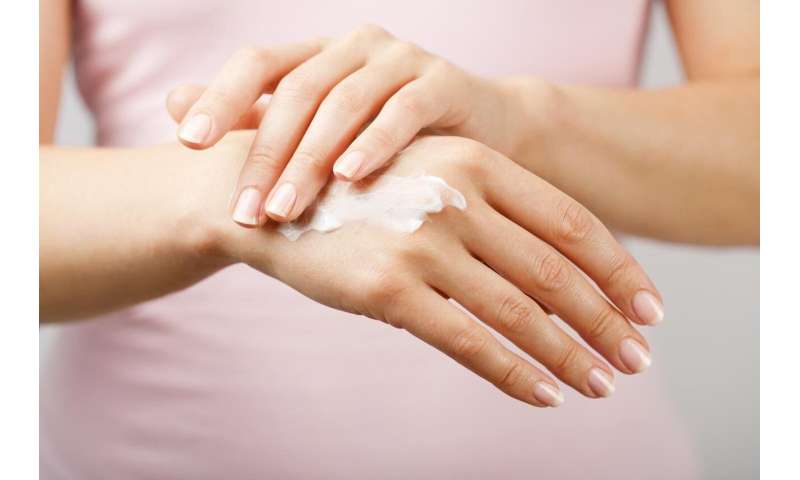
A layer of lipids covers our skin, and with its help our skin retains moisture and remains healthy. In the lipid layer, a compound called ceramide forms a "lamellar gel" with cholesterol, fatty acids, and water. Lamellar gels are mixtures that are thick, do not flow easily, and can hold large amounts of water. Natural ceramide is therefore an important factor for water retention in our skin. A type of lamellar gel, called the "α-gel," can be formulated by mixing compounds called surfactants with a fatty alcohol and water. As you may have guessed by this explanation, α-gels are widely used in skincare products such as skin creams.
In a new study published in Colloids and Surfaces A, scientists from Tokyo University of Science and Miyoshi Oil and Fat Co. Ltd., Japan, led by Dr. Kenichi Sakai, synthesized an α-gel using an oleic acid-based surfactant, which can potentially be used in skincare products. This is a surfactant they had previously developed and is structurally similar to natural ceramide (both are amphiphiles with two tails). "I was interested in whether α-gels could be prepared using gemini surfactants (two-tailed and two-headed surfactants), and in what their structural and physical properties would be," Dr. Sakai says.
Once the α-gel was ready, Dr. Sakai and his team used a technique called small- and wide-angle X-ray scattering (SWAXS), another technique called nuclear magnetic resonance (NMR) spectroscopy, and an optical microscope to confirm its characteristics. For this, they prepared several mixtures containing different molar ratios of the oleic acid-based surfactant, water, and 1-tetradecanol (a fatty alcohol). The findings were, indeed, satisfactory.
SWAXS measurements revealed the typical lamellar or sheet-like structure of α-gels: layers of molecules stacked over each other such that a vertical cross-section has molecules aligned in straight lines and a horizontal cross-section could appear hexagonal. This means that the prepared mixture formed an α-gel. The structure remained highly ordered even when 90% of the mixture by weight was water.
When the scientists further analyzed the SWAXS measurements, they found that increasing the molar content of the fatty alcohol in the mixture increases the space between the molecular "bilayers" in the stacked-structure of the α-gel. Bilayers are a pair of molecular layers in which the tail-ends of both layers point to each other. A property of α-gels is that water fills the space between these bilayers. In this case, the scientists think that the increase in the space between the bilayers must be because more water filled it.
NMR spectroscopy then showed that fatty alcohol molar content increase also caused a decrease in the movement of protons within the molecular bilayers, which is in keeping with characteristics lamellar gels are known to have.
Dr. Sakai and his team were also aware that α-gels systems are known to demonstrate "shear thinning," i.e., when they are pressed and dragged against a surface, they spread out evenly as a dollop of paint would do when applied to a wall with a brush. All mixtures in the study showed shear thinning, so the scientists looked through an optical microscope to find out why. They saw a progressive and specific change in the structure of the α-gel with an increase in fatty alcohol content. Reports of previous studies had told them that this specific structural change causes α-gels to become as thick as is necessary for shear thinning.
Thus, overall, the prepared α-gel's ability to hold water and spread out evenly over surfaces makes it suitable for skincare products such as skin creams. What's more, the oleic acid-based surfactant is readily soluble in water, and so its production is easier and possible at low energy-costs. Dr. Sakai explains, "It is an environment-friendly functional organic material because even when it is added in small amounts, it exhibits surface chemical functions not inferior to those of conventional surfactants."
So, cross your fingers; the perfect skin cream may be here soon!
Explore further
Citation: With this new alpha-gel, the cream of all skin creams could be here (2019, October 23) retrieved 23 October 2019 from https://ift.tt/2NcuYDU
This document is subject to copyright. Apart from any fair dealing for the purpose of private study or research, no part may be reproduced without the written permission. The content is provided for information purposes only.
"cream" - Google News
October 23, 2019 at 10:53PM
https://ift.tt/2NcuYDU
With this new alpha-gel, the cream of all skin creams could be here - Phys.Org
"cream" - Google News
https://ift.tt/2MOPaLD
Shoes Man Tutorial
Pos News Update
Meme Update
Korean Entertainment News
Japan News Update
No comments:
Post a Comment